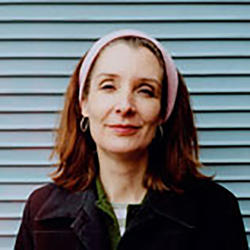Jean Blackburn

Jean Blackburn has been teaching at RISD since 1982 as a member of the Illustration department. A long-time resident of New York, she moved north in 2001 and currently resides in a firehouse in Rhode Island.
Blackburn’s work, both painting and sculpture, addresses the domestic setting and its power to shape or reflect our understanding of the world. She has exhibited her work throughout the US and abroad, including the DeCordova Museum, the Brooklyn Museum, the Aldrich Museum and the John Michael Kohler Arts Center.
Most recently Blackburn was included in the exhibition Transitional Objects at the Neuberger Museum and at the Ierimoti Gallery in Milan. Her work is in collections of the Mint Museum, the Tang Museum and many private collections.
Academic areas of interest
Jean has a strong interest in ancient civilizations. She has worked as an archaeological illustrator on excavations in New England, New Mexico and Petra, Jordan.
Courses
Fall 2024 Courses
ILLUS 2012-01
DRAWING I: VISUALIZING SPACE
SECTION DESCRIPTION
The convincing depiction of form in three-dimensional space is one of the great conceptual and philosophic breakthroughs of Western art. In this class, the first half of the sophomore drawing sequence, our main focus will be the study of form in a spatial context. We will use observational and projected systems of perspective in construction of our images. Emphasis will be placed on exploration of conceptual and physical viewpoint, effective composition and convincing light and shadow to shape expression, engage the viewer and create a unified pictorial image. The class will promote acute observation of existing spatial situations, the invention of convincing imagery from imagination, and the successful integration of the two. Exposure to traditional and contemporary drawing masters and practices will provide inspiration for experimentation, personal expression and artistic growth. A series of perspectival studies will build into longer projects integrating observation and invention and concerns for figure and ground. Students will come to grasp the elegance and power of perspective as an approach to drawing, tempered with an awareness of its limitation and alternatives. Several black and white media in addition to charcoal (mixed media, collage, monoprint, caran dache, pastel, etc) and various ways of working (line weight, cross-hatching, additive, subtractive) may be explored.
Majors are pre-registered for this course by the department.
Major Requirement | BFA Illustration
ILLUS 3772-01
3-D ILLUSTRATION
SECTION DESCRIPTION
While most illustrations are flat, working in three dimensions allows for the engagement of a whole new range of material and conceptual possibilities. Whether using traditional materials or digital technologies, sculpture is enormously nuanced in what it can suggest. In this class we will examine how objects and various sculptural strategies can be used to convey complex concepts and ideas. A survey of contemporary sculpture and 3D illustration will provide plenty of conceptual, process and material exploration. The class is offered in conjunction with RISD CoWorks to promote experimentation, interdisciplinarity, and access to advanced technologies. Projects are structured to introduce you to a variety of materials and methods of working, including paper manipulation, box making, character design, model-making, 3D printing, and laser-cutting. Additionally students will learn how to light and photograph three-dimensional work for reproduction or portfolio. The class promotes development of personal expression, strong conceptual solutions, excellent craftsmanship and good design.
Estimated Cost of Materials: $100.00
Elective
Spring 2025 Courses
ILLUS 3104-01
VISIBLE CITIES
SECTION DESCRIPTION
A society's history is written in its stones. From the dystopias of Gotham City or Grand Theft Auto, the hive mind of the Borg and the ecstatic asceticism of the Shakers, to the suburban conformity of Levittown and the Sphinx half buried in sand, every city, every society, is an embodiment of ideas, history, geography, and beliefs. Each built environment has its own logic, both architectural and cultural. With some provocative writings about the phenomenon of the city as inspiration, you will be asked to conceptualize a place and bring it to life visually. The essence of a city - its buildings, pathways, public and private spaces - depends on how you define the character of its people, its government, its history, its geographic siting and even its language. After defining a back-story in broad strokes, you will begin researching the implications of those choices visually. Working from thumbnails and sketches to finished conceptualization, you will explore compelling physical and conceptual viewpoints, with a variety of possibilities in the use of media and technique. Rather than limiting ourselves to purely pragmatic architecture, the class will be searching for imaginative visualizations, where form becomes poetic metaphor suggestive of narrative.
This course fulfills the Illustration Concepts Elective requirement for Illustration majors.
Elective
ILLUS 3916-01
SCIENTIFIC ILLUSTRATION
SECTION DESCRIPTION
From Leonardo's rich notebook studies to Audubon's great horned owl, to NASA's Mars Rover simulations, scientific illustration derives from rich traditions stressing scientific investigation, good design, close observation and technical mastery. We will begin with a study of the structuring strategies nature uses to create its enormous diversity of forms. Scientific drawing conventions, interesting drawing techniques and tools will be presented. Students will produce a variety of black and white, color and digital solutions exploring aspects of this broad field. The class will culminate with a final project allowing each student to explore a scientific area of interest.
Elective